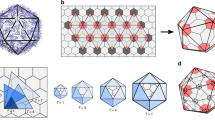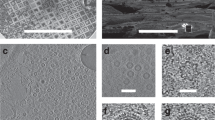Abstract
The discovery that the 72 capsomeres of the icosahedrally symmetric polyoma virus capsid are all pentamers1 shows that the expected quasi-equivalent bonding specificity2 is not conserved in the assembly of this virus coat protein. Tubular particles produced by polyoma and other papovaviruses seem to be polymorphic aggregates of capsomeres3 that may arise through variation in switching of the bonding specificity. Electron micrographs of wide and narrow classes of tubes were analysed by Kiselev and Klug4 using optical diffraction and optical filtering methods. The wide type were called ‘hexamer’ tubes because they consist of approximately hexagonally arrayed capsomeres that were assumed to be hexamers4, in accord with the quasi-equivalence theory of icosahedral virus particle construction2. The narrow type were called ‘pentamer’ tubes because the capsomeres are arrayed in a particular ‘pentagonal tessellation’ which arises from the pairing of pentamers across 2-fold axes of the surface lattice4. Our reexamination of negatively-stained polyoma virus tubes by digital image processing of low-irradiation electron micrographs shows that all tubes are assemblies of paired pentameric capsomeres. We report here that the packing arrangement of the pentamers in the hexamer tubes is simply related to the pentagonal tessellation4 representing the packing in the narrow pentamer tubes. In all the tube structures examined, at least one pairwise contact between neighbouring pentamers closely resembles the contact between the pentavalent and hexavalent capsomeres in the icosahedral capsid1.
Similar content being viewed by others
References
Rayment, I., Baker, T. S., Caspar, D. L. D. & Murakami, W. T. Nature 295, 110–115 (1982).
Caspar, D. L. D. & Klug, A. Cold Spring Harb. Symp. quant. Biol. 27, 1–24 (1962).
Finch, J. T. & Klug, A. J. molec. Biol. 13, 1–12 (1965).
Kiselev, N. A. & Klug, A. J. molec. Biol. 40, 155–171 (1969).
Baker, T. S. & Amos, L. A. J. molec. Biol. 123, 89–106 (1978).
Moody, M. F. J. molec. Biol. 25, 167–200 (1967).
Rayment, I. Acta crystallogr. A39, 102–116 (1983).
Rayment, I., Baker, T. S. & Caspar, D. L. D. Acta crystallogr. B39 (1983).
Author information
Authors and Affiliations
Rights and permissions
About this article
Cite this article
Baker, T., Caspar, D. & Murakami, W. Polyoma virus ‘hexamer’ tubes consist of paired pentamers. Nature 303, 446–448 (1983). https://doi.org/10.1038/303446a0
Received:
Accepted:
Issue Date:
DOI: https://doi.org/10.1038/303446a0
- Springer Nature Limited
This article is cited by
-
DNA-origami-directed virus capsid polymorphism
Nature Nanotechnology (2023)
-
Encapsulation of DNA and non-viral protein changes the structure of murine polyomavirus virus-like particles
Archives of Virology (2008)
-
Structure of simian virus 40 at 3.8-Å resolution
Nature (1991)
-
Molecular structure: Architectural design of spherical viruses
Nature (1983)





